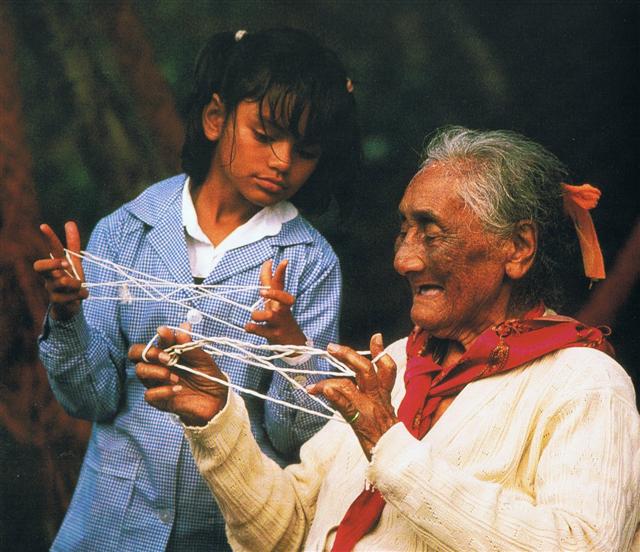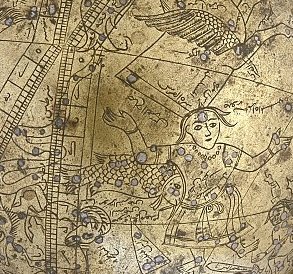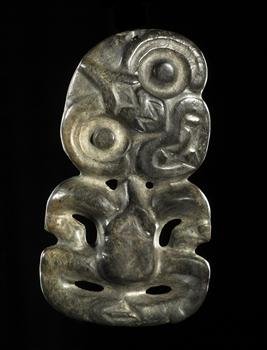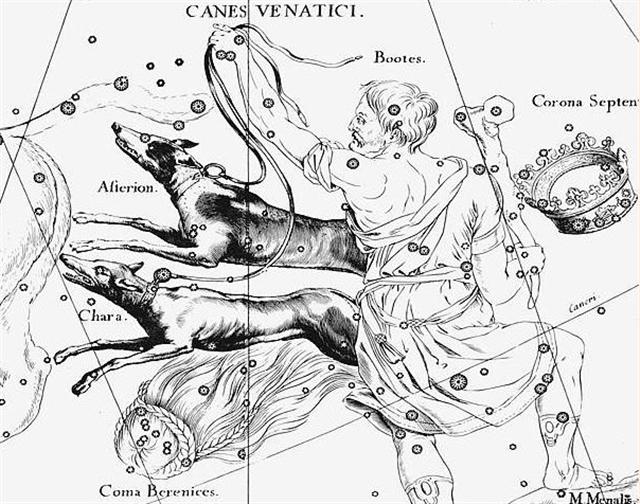When Mother Nature came alive again in spring,
marvellously regenerating it all, then the old dry year of straw
had to go in order not to disturb the wonderful scenery.

...
What happens after
(or happened, or will happen sometime, for this myth is written
in the future tense), is told in the V÷luspa, but it is also
amplified in Snorri's Gylfaginning (53), a tale of a
strange encounter of King Gylfi with the Aesir themselves,
disguised as men, who do not reveal their identity but are
willing to answer questions: 'What happens when the whole world
has burned up, the gods are dead, and all of mankind is gone?
You have said earlier, that each human being would go on living
in this or that world.' So it is, goes the answer, there are
several worlds for the good and the bad. Then Gylfi asks: 'Shall
any gods be alive, and shall there be something of earth and
heaven?' And the answer is:
'The earth rises up
from the sea again, and is green and beautiful and things grow
without sowing. Vidar and Vali are alive, for neither the sea
nor the flames of Surt have hurt them and they dwell on the
Eddyfield, where once stood Asgard. There come also the sons of
Thor, Modi and Magni, and bring along his hammer. There come
also Balder and Hoder from the other world. All sit down and
converse together. They rehearse their runes and talk of events
of old days. Then they find in the grass the golden tablets that
the Aesir once played with.
Two children of men
will also be found safe from the great flames of Surt. Their
names, Lif and Lifthrasir, and they feed on the morning dew and
from this human pair will come a great population which will
fill the earth. And strange to say, the sun, before being
devoured by Fenrir, will have borne a daughter, no less
beautiful and going the same ways as her mother.'
Then, all at once, concludes Snorri's tale wryly, a thunderous
cracking was heard from all sides, and when the King looked
again, he found himself on the open plain and the great hall had
vanished ...
There could have been an abrupt transfer of old
winter from
spring to the winter solstice, we have seen, to day 104 (April 14, 4-14) +
183 + 68 (precessional depth down to the time of Aldebaran) =
355 (December 21).
And there could have been a complementary transfer
of dead summer across to spring. The Babylonian zodiac
illustrates how a bound and immobilized Dead Man would be carried
along the path of the Milky Way:

... All 'change
stations' are found invariably in two regions: one in the South
between Scorpius and Sagittarius, the other in the North between
Gemini and Taurus; and this is valid through time and space,
from Babylon to Nicaragua. Why was it ever done in the first
place? Because of the Galaxy, which has its crossroads with the
ecliptic between Sagittarius and Scorpius in the South, and
between Gemini and Taurus in the North
... Men's
spirits were thought to dwell in the Milky Way between
incarnations. This conception has been handed down as an Orphic
and Pythagorean tradition fitting into the frame of the
migration of the soul ...
If the front side (a) of a rongorongo
tablet was heliacal (dominated by the light from the Sun) and the back side
(b) was illustrating the time
of the Full Moon against the background of the fixed stars, then
a continuation of the reading from the end of the back side on to the
beginning of side a ought to imply a return from star time to
heliacal, a rebirth in order to complete the cycle - as in
Faka-taka, the mother of Tae-tagaloa (Not-tangaroa):
... There is a couple
residing in one place named Kui and Fakataka.
After the couple stay together for a while Fakataka is
pregnant. So they go away because they wish to go to another
place - they go. The canoe goes and goes, the wind roars, the
sea churns, the canoe sinks. Kui expires while
Fakataka swims.
Fakataka
swims and swims, reaching another land. She goes there and stays
on the upraised reef in the freshwater pools on the reef, and
there delivers her child, a boy child. She gives him the name
Taetagaloa. When the baby is born a golden plover flies over
and alights upon the reef.
(Kua fanau lā te pepe kae lele mai te tuli oi tū mai i te
papa). And
so the woman thus names various parts of the child beginning
with the name 'the plover' (tuli): neck (tuliulu),
elbow (tulilima), knee (tulivae)
...
|
Tui
1. To sew mats, to make strings.
E-tahi tuitui reipß i Te Pei, ekˇ rava'a e-varu kaukau;
i-garo ai i Hiva, i te kaiga, a necklace of
mother-of-pearl is on te Pei, few will find it
(lit: eight groups of people); it has remained in
Hiva, in our homeland. 2. The three stars of Orion's
Belt. Vanaga. |
|
Taka
Taka,
takataka.
Circle; to form circles, to gather, to get together (of
people). Vanaga.
1. A dredge. P Mgv.:
akataka, to
fish all day or all night with the line, to throw the
fishing line here and there. This can only apply to some
sort of net used in fishing. We find in Samoa
ta'ā a small fishing
line, Tonga taka the short line attached to fish
hooks, Futuna taka-taka a fishing party of women
in the reef pools (net), Maori takā the thread by
which the fishhook is fastened to the line, Hawaii
kaa in the same sense, Marquesas takako a
badly spun thread, Mangareva takara a thread for
fastening the bait on the hook. 2. Ruddy. 3. Wheel,
arch; takataka, ball, spherical, round, circle,
oval, to roll in a circle, wheel, circular piece of
wood, around; miro takataka, bush; haga
takataka, to disjoin; hakatakataka, to round,
to concentrate. P Pau.: fakatakataka, to whirl
around. Mq.: taka, to gird. Ta.: taa,
circular piece which connects the frame of a house.
Churchill.
Takai, a
curl, to tie; takaikai, to lace up; takaitakai,
to coil. P Pau.: takai, a ball, to tie. Mgv.:
takai, a circle, ring, hoop, to go around a thing.
Mq.: takai, to voyage around. Ta.: taai,
to make into a ball, to attach. Churchill. |

On the C tablet glyph number 368 (*Ca14-5) was at the
southern spring equinox and 392 (glyphs on side a) - 368 = 24
can therefore be added to 348, the number of glyphs on side b. 740
(total number of glyphs on the tablet) - 368 = 372 (= 24 +
348) was the glyph number at Starry (Asterion, β
Canes Venatici, the northern of the pair of dogs). This was at the
central vero in line Ca14:
|
*JULY 12 |
13 |
14
(*115) |
15 |
16 |
17
(*186 - 68) |
|
September 18 (9 *
29) |
19 |
20
(*183) |
21
(264) |
Equinox |
23 |
|
π Virginis (181.0),
θ Crucis (181.5) |
12h
(182.6)
ο Virginis
(182.1), η Crucis (182.5) |
ALCHITA = α
Corvi,
MA WEI (Tail of the Horse)
= δ Centauri (183.1),
MINKAR
(Nose) = ε
Corvi (183.7), ρ Centauri (183.9) |
P┴LIDA (Pale)
= δ Crucis (184.6),
MEGREZ (Root of the Tail)
= δ Ursae Majoris (184.9) |
Hasta-13 (Hand) /
Chariot-28
GIENAH (Wing)
= γ Corvi (185.1), ε Muscae (185.2), ζ Crucis
(185.4),
ZANIAH (Corner)
= η Virginis (185.9) |
CHANG SHA (Long Sand-bank)
= ζ Corvi (186.3) |
 |
 |
 |
 |
 |
 |
|
*Ca14-1 |
*Ca14-2 |
*Ca14-3 (366) |
*Ca14-4 |
*Ca14-5 |
*Ca14-6 |
|
Kua tupu te ata i te henua |
kua ruku te manu |
|
March 19 (78) |
20 |
21
(0h) |
22
(81 + 366) |
23
(*368) |
24
(449) |
|
η
Tucanae (363.0), ψ Pegasi (363.1), 32 Piscium
(363.2), π Phoenicis (363.4), ε Tucanae (363.6),
τ Phoenicis (363.9) |
θ
Oct. (364.4) |
Al
Fargh al Thāni (Rear Spout) -25
0h
(365.25)
CAPH (Hand)
= β
Cassiopeiae,
SIRRAH (Navel of the Horse)
= α
Andromedae (0.5), ε Phoenicis, γ│ Oct. (0.8) |
Uttara Bhādrapadā-27
/
Wall-14
ο
Oct. (1.3),
ALGENIB
PEGASI
= γ
Pegasi (1.8) |
χ
Pegasi (2.1), θ Andromedae (2.7) |
σ
Andromedae (3.0), ι Ceti (3.3), ζ Tucanae (3.5),
ρ Andromedae, π Tucanae (3.7) |
|
*JANUARY 11 |
12 |
13 |
14 |
15 |
16 |
|
*JULY 18 |
19
(200) |
20
(*121) |
21 |
22 /
7 |
|
September 24 (*187) |
25 |
26 |
27
(270) |
28 |
|
INTROMETIDA =
ε Crucis (187.4),
ACRUX = α
Crucis (187.5) |
γ Com. Berenicis
(188.0), σ Centauri (188.1),
ALGORAB = δ
Corvi (188.5),
GACRUX = γ
Crucis (188.7) |
γ Muscae (189.0),
AVIS
SATYRA = η
Corvi
(189.3),
ASTERION (Starry) = β Canum Ven.
(189.5),
KRAZ
= β Corvi, κ
Draconis (189.7) |
α Muscae (190.2), τ
Centauri (190.5), χ Virginis (190.7)
ALDERAMIN (α Cephei)
|
Al ┴wwā'-11 /
Shur-mahrū-shirū-18 (Front or West Shur?)
Sombrero
Galaxy = M104 Virginis (191.1), ρ Virginis
(191.4),
PORRIMA = γ
Virginis, γ Centauri (191.5) |
 |
 |
 |
 |
 |
|
*Ca14-7 (370) |
*Ca14-8 |
(372
= 12 * 31) |
*Ca14-10 |
*Ca14-11 |
|
te kihikihi - te hoea |
te kihikihi - o te vai - te kihikihi |
te vero |
te henua |
te heke |
|
Julian equinox |
March 26 |
27
(*372) |
28 |
29
(454 = 88 + 366) |
|
'February 26 |
27 |
28
(*345 = *372 - 27) |
'March 1 (60) |
2 |
|
"February 12 (*329) |
13 |
All Hearts'
Day |
15 |
16
(413 = 14 * 29Ż) |
|
no
star listed (4) |
ANKAA
= α
Phoenicis, κ Phoenicis (5.0)
ALPHARD
(α Hydrae) |
λ
Phoenicis (6.3), β Tucanae (6.4) |
Andromeda Galaxy (M31), π Andromedae (7.7) |
ε Andromedae (8.2),
DELTA
= δ Andromedae (8.4),
SCHEDIR (Breast)
= α
Cassiopeiae (8.6), ζ Andromedae, μ Phoenicis
(8.9) |
|
*JANUARY 17 |
18 |
(384 = 354 +
30) |
20 |
21 |
In Manuscript E the star Bharani (41
precessional days earlier than the time of rongorongo) seems to have been used for
timing the
events of the Explorers (the movements of the planets in the night
when the daytime Sun had not yet arrived).
| EXPLORERS IN THE NIGHT: |
ORIGINAL POPULATION: |
| Ira |
Sun |
Kuukuu |
Mars |
Nga Tavake A Te Rona |
| Raparenga |
Moon |
Ringiringi |
Mercury |
Te Ohiro A Te Runu |
| |
Nonoma |
Jupiter |
|
| Uure |
Venus |
| Makoi |
Saturn |
| Sons of Hau Maka |
Sons of Hua Tava |
Sons of Te Rona / Te Runu |
And side a
on the G tablet evidently began at Ain (the Eye), 4 precessional days
after Aldebaran (68 precessional days before the time of
rongorongo), which made for an interesting parallel in
structure
regarding the key number 27 (= 3 * 3 * 3):
|
Time of rongorongo |
=
Roman times + 27 days |
|
Time of Bharani |
= Aldebaran times +
27 (= 68 - 41) |
Furthermore, 183 + 27 = 210:
|
PHEKDA
(Thigh) |
9 |
CANES
VENATICI |
|
ASTERION
(Starry, β) |
5 |
COR
CAROLI (α) |
|
*JULY 10
(*111) |
*JULY 20
(*121) |
*JULY 26
(*127) |
 |
 |
 |
|
Ca13-19
(362) |
*Ca14-9
(372) |
*Ca14-15
(378) |
|
*JANUARY
9 (374) |
*JANUARY
19 (384) |
*JANUARY 25 (390) |
|
16 |
14 * 15
=
210
= 390 - 180 |
|
*JULY 7 (256 - 68) |
8
(325 - 2 * 68) |
9
(*174 - 64) |
10
(*179 - 68) |
11 (192) |
|
September 13 (256) |
14
(325 - 68) |
15 |
16 |
17
(*180) |
|
ο Hydrae (176.1) |
ζ Crateris, ξ
Virginis (177.0), λ Muscae (177.1), ν Virginis
(177.2), μ Muscae (177.8) |
Al Sarfah-10 /
Uttara Phalguni-12 /
Zibbat A.-16
(Tail of the Lion) / Shēpu-arkū sha-A-17
(Hind Leg of the Lion)
93 Leonis (178.0),
DENEBOLA
= β Leonis
(178.3),
ALARAPH
(Hind Leg)
= β Virginis
(178.6) |
PHEKDA (Thigh)
= γ Ursae Majoris, β Hydrae (179.3), η Crateris
(179.9)
DENEB CYGNI (α
Cygni)
|
no star listed (180) |
 |
 |
 |
 |
 |
|
Ca13-16 |
Ca13-17 (360) |
Ca13-18 |
Ca13-19 |
Ca13-20 |
|
oho te vae |
tagata puoko erua |
tagata puo pouo |
vero hia |
- |
|
March 14 (3-14, 73) |
15
(*360) |
16
(75 + 366) |
17
(442) |
18 |
|
λ Piscium (358.0),
MANUS CATENATA
(Chained Hand)
= ι Andromedae (358.1),
ALRAI (Shepherd)
= γ Cephei, θ Phoenicis (358.4), κ Andromedae
(358.7) |
ω
Aquarii (359.2), 78 Pegasi (359.5) |
ψ
Andromedae (360.1), σ Phoenicis (360.4) |
γ╣
Oct. (361.4), φ Pegasi (361.7) |
DZANEB (Tail)
= ω
Piscium (362.4), γ▓ Oct. (362.8) |
|
*JANUARY 6 |
7 |
8
(373 = 441 - 68) |
9
(378 - 4) |
10
(*295) |

...
Alpheratz, Alpherat, and Sirrah are
from the Arabians' Al Surrat al Faras, the
Horse's Navel, as this star formerly was associated with
Pegasus, whence it was transferred to the Woman's hair;
and some one has strangely called it Umbilicus
Andromedae. But in all late Arabian astronomy taken
from Ptolemy it was described as Al Rās al Mar'ah al
Musalsalah, the Head of the Woman in Chains
...

... 'From the
time I was in your womb,' Maui went on, 'I have
known the names of these children of yours. Listen,' he
said as he pointed to his brothers in turn. 'You are
Maui mua, you are Maui roto, you are Maui
taha, and you are Maui pae. And as for me, I
am Maui potiki, Maui-the-last-born. And
here I am.' When he had finished, Taranga had to
wipe her eyes because there were tears in them, and she
said: 'You are indeed my lastborn son. You are the child
of my old age. When I had you, no one knew, and what you
have been saying is the truth. Well, as you were formed
out of my topknot you can be Maui tikitiki a Taranga.'
So that became his name, meaning Maui-formed-in-the-topknot-of-Taranga.
And this is very strange, because women in those days
did not have topknots. The topknot was the most sacred
part of a person, and only men had them
...

|
*JULY 23 (204) |
24 |
25 |
26 (*127) |
27 |
28 |
|
Sept 29 (272) |
30 (*193) |
October 1 |
2 |
3 |
4 |
|
ι Crucis
(192.2), β Muscae (192.5),
MIMOSA =
β Crucis (192.9) |
no star listed
(193) |
κ Crucis
(194.4), ψ Virginis (194.5), μ Crucis, λ
Crucis (194.6),
ALIOTH (Fat Tail)
= ε Ursae Majoris, ι Oct. (194.8) |
MINELAUVA
= δ Virginis (195.1),
COR CAROLI
= α Canum Ven.
(195.3) |
δ Muscae
(196.5),
VINDEMIATRIX (Grape Gatherer)
= ε Virginis
(196.8) |
13h (197.8)
ξ╣
Centauri (197.1), ξ▓ Centauri (197.9) |
 |
 |
 |
 |
 |
 |
|
*Ca14-12 |
*Ca14-13 |
*Ca14-14 |
*Ca14-15 (378) |
*Ca14-16 |
*Ca14-17 |
|
te kihikihi |
o te henua - kua haga
hia |
kua pua |
te vero |
te henua |
kiore - te henua |
|
March 30 |
31 (*10) |
April 1 |
2 (92 = *378 - 366 + 80) |
3 |
4 |
|
ξ Phoenicis (9.0), ρ
Tucanae (9.1),
DENEB KAITOS
= β Ceti, η Phoenicis (9.4),
AL NITHĀM (String of Pearls)
= φ╣ Ceti (9.6) |
ACHIRD (Woman with Luminous Rays)
= η Cassiopeiae (10.7) |
Legs-15
(Wolf)
ν Andromedae (11.0), φ▓ Ceti (11.1), ρ
Phoenicis (11.2),
η ANDROMEDAE
(11.4) |
CIH (Whip)
= γ Cassiopeiae, λ Tucanae (12.4), φ│ Ceti
(12.6), μ Andromedae (12.8) |
φ4 Ceti (13.2) |
no star listed (14) |
|
*JANUARY 22 |
(388 = 392 - 4) |
24 |
25 (210 + 180) |
26 |
27 (392) |

|













